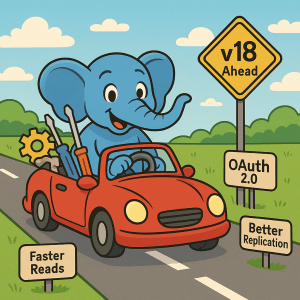PostgreSQL 18 is on the way, bringing a set of improvements that many organizations will find useful. It’s not a revolutionary release, but it does move things in a good direction, especially in performance, replication, and simplifying daily operations.
For teams already using PostgreSQL, it’s a good time to look into what’s new. For others considering a switch, this release adds a few more reasons to take that step.
What’s changing and why it matters

Enterprise authentication comes to PostgreSQL
PostgreSQL 18 introduces OAuth 2.0, a widely used authentication standard in enterprise environments. Chances are, your security team has already been asking about OIDC, and this is the step that makes it possible.
Better performance in common cases
PostgreSQL 18 delivers a set of optimizations that reduce overhead in popular operations. These improvements are mainly focused on sorting and reading data. While each change might be modest on its own, together they improve query performance and resource use, especially for read-heavy or analytical workloads.
Logical replication is getting more flexible
There’s been a steady flow of improvements to logical replication in recent PostgreSQL releases. This release is no exception and continues this streak, including new support for bidirectional setups. This means more tools for those building distributed or multi-region systems, with fewer external dependencies.
Smoother operations
Changes in how memory is handled and some updated defaults make PostgreSQL behave better out of the box. It won’t remove all complexity or make tuning obsolete (we can dream), but it does make PostgreSQL easier to run out of the box and should save time when troubleshooting.
More consistency in edge cases
Several under-the-hood changes improve how PostgreSQL handles replays and provide better consistency around failovers. This helps reduce edge cases and makes PostgreSQL slightly more predictable under load. This is especially helpful in HA setups, exactly the kind that architects and operators are regularly asked about by the business.
What to do now
As the release of PostgreSQL 18 is planned for September 2025, there’s no need to rush. But it’s a good time to:
- Review what’s coming in PostgreSQL 18 and talk to your teams about adopting the new features
- Test the beta version already against your workloads
- Think about where it could simplify your setup or reduce manual tuning
If you’re already a few versions behind, this release adds another reason to plan an upgrade. If you need convincing, do check out this very useful tool that allows you to list all the reasons to update from version to version, focusing on CVEs based on the keyword selection.
Final thoughts
Postgres is a robust and reliable database, and as such, it does not introduce revolutions. Rather than that, PostgreSQL 18 reflects the project’s ongoing, steady progress. This version adds useful capabilities where they matter and builds on what’s already working.
This steady, practical release makes PostgreSQL easier to run and a bit more efficient in production. It is yet another reason for decision makers to keep trusting it as a long-term foundation for their data infrastructure.
At Percona, we’re already testing it and following its behavior in real environments. If you’d like to talk about how it might fit into your plans, we’re happy to help.
Get in touch with us to learn more.
To read more details about the upcoming improvements, check out:








